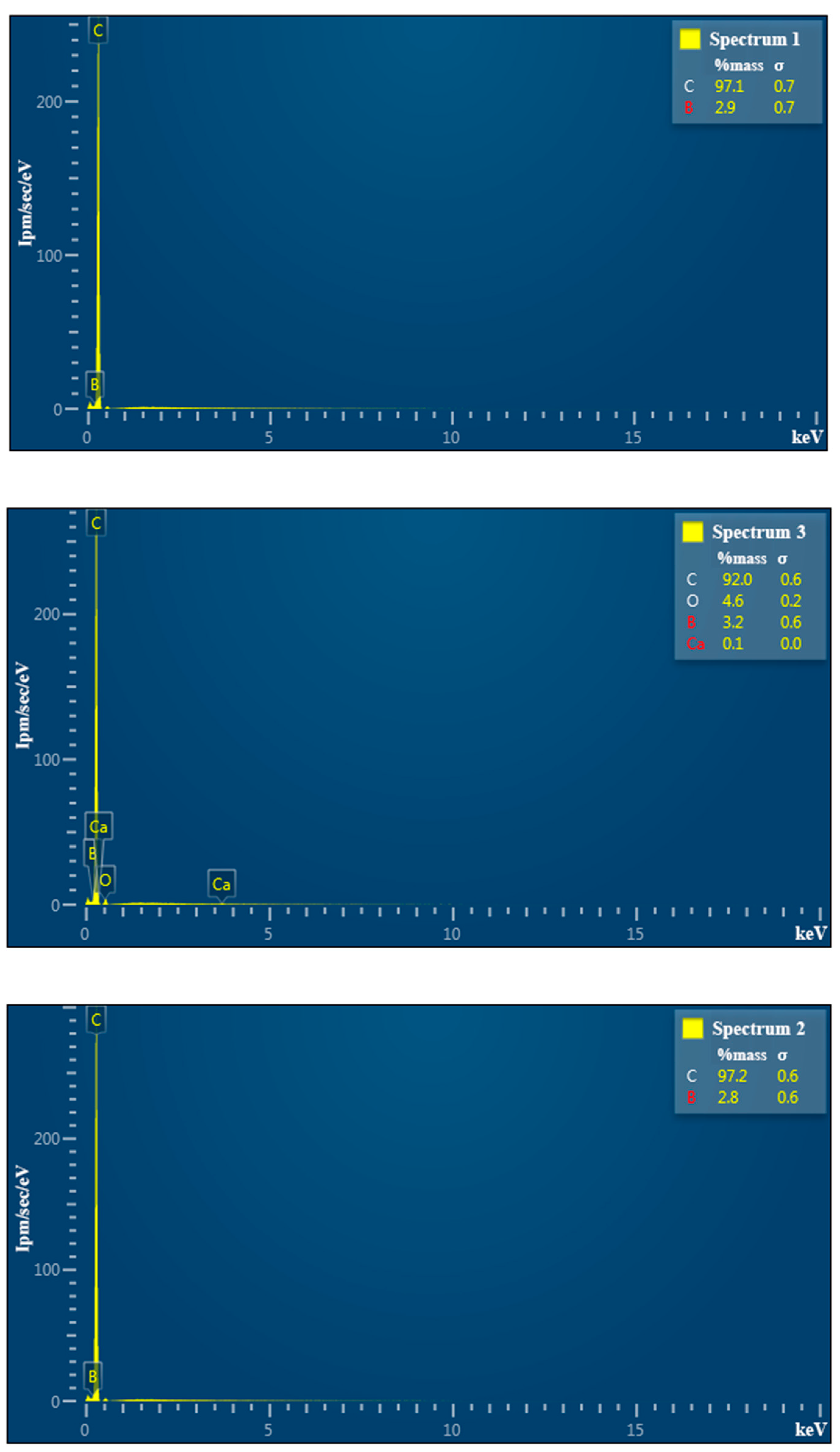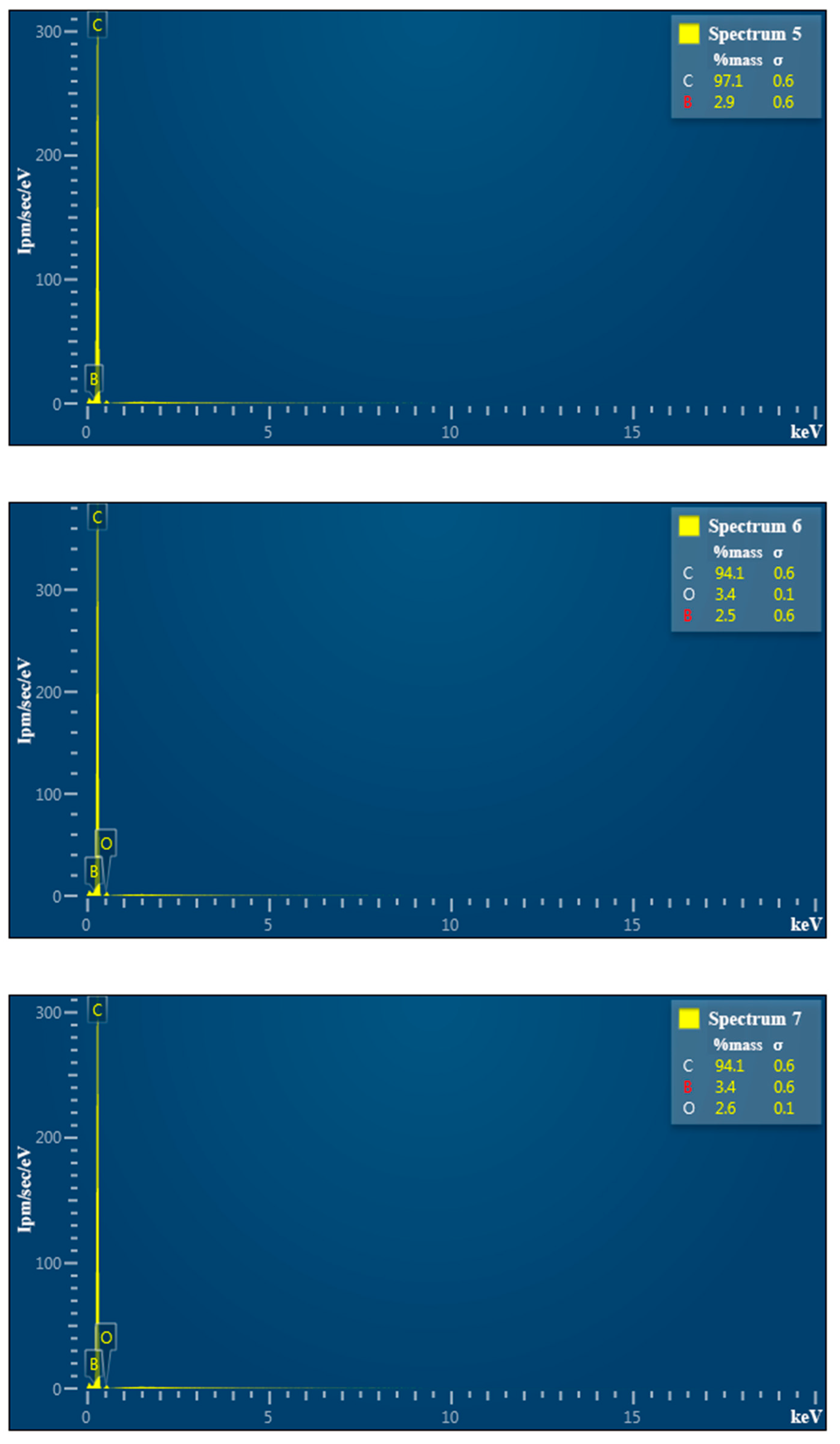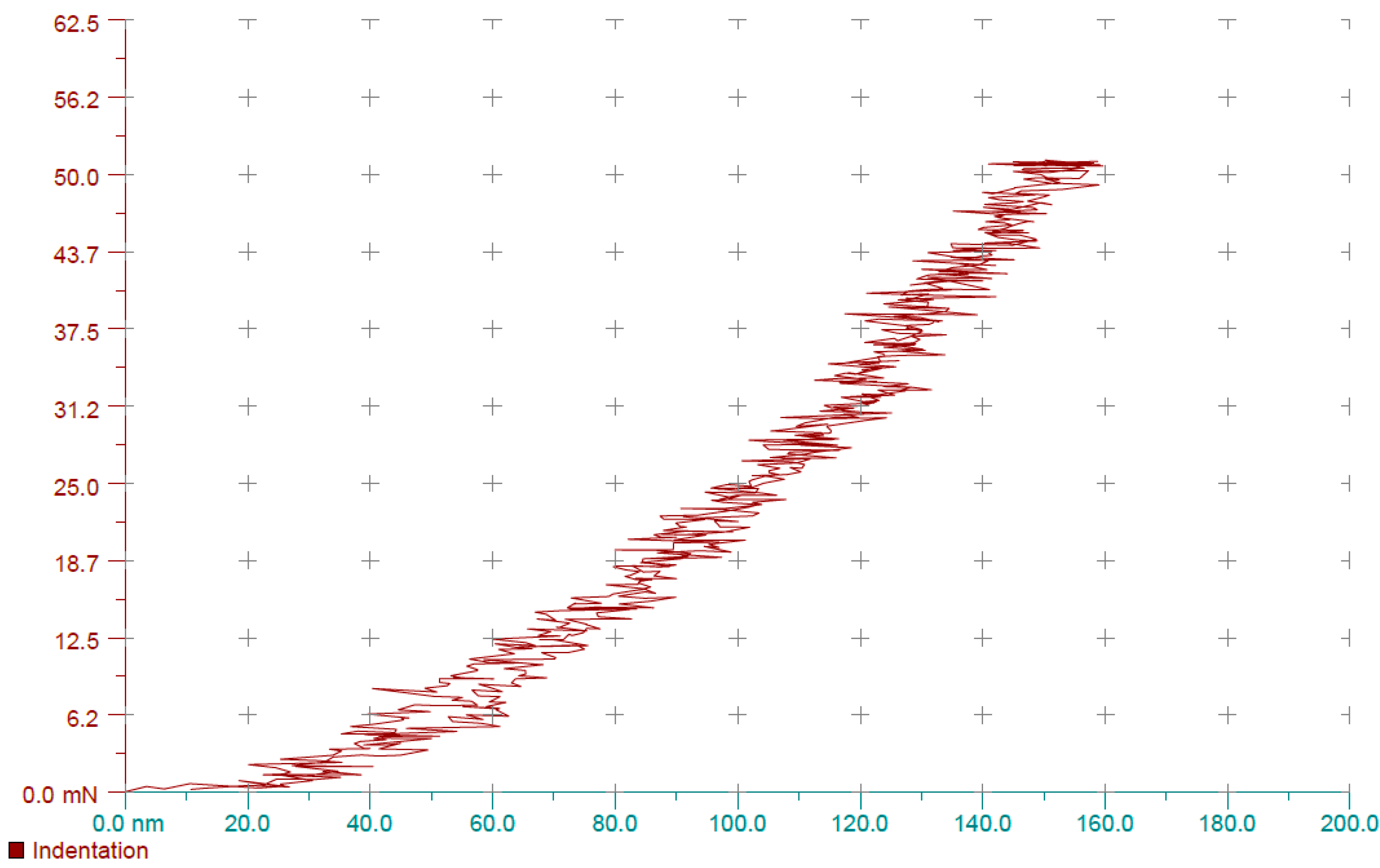Deposition of Boron-Doped Thin CVD Diamond Films from Methane-Triethyl Borate-Hydrogen Gas Mixture
Abstract
:1. Introduction
- To find an appropriate boron-containing substance.
- To optimize the process of synthesis of boron-doped diamond of small thickness.
- To optimize the process of synthesis of thick layers of boron-doped diamond due to its constant etching.
2. Materials and Methods
2.1. Materials
2.2. Scanning Electron Microscopy and X-ray Microanalysis
2.3. The Hardness and Elastic Modulus of Coatings
2.4. Preparing the Single-Crystal Diamond Surface and the Thin-Layer Doping Process
3. Results and Discussions
3.1. Scanning Electron Microscopy and Elemental Analysis
3.2. The Hardness and Elastic Modulus
- -
- hardness 62.8 GPa;
- -
- elastic modulus 914.6 GPa;
- -
- indenter penetration depth 155.816 nm.
- -
- temperature 1100 °C;
- -
- H2 flow rate 480 cm3/min;
- -
- CH4 flow rate 25 cm3/min;
- -
- H2 – (C2H5O)3B flow rate 10 cm3/min;
- -
- microwave power 3800 W;
- -
- reactor pressure 9.806 kPa.
4. Conclusions
Author Contributions
Funding
Conflicts of Interest
References
- Jia, F.; Bai, Y.; Qu, F.; Zhao, J.-J.; Zhuang, C.; Jiang, X. Effect of B/C ratio on the physical properties of highly boron-doped diamond films. Vacuum 2010, 84, 930–934. [Google Scholar] [CrossRef]
- Rehacek, V.; Hotový, I.; Marton, M.; Mikolasek, M.; Michniak, P.; Vincze, A.; Kromka, A.; Vojs, M. Voltammetric characterization of boron-doped diamond electrodes for electroanalytical applications. J. Electroanal. Chem. 2020, 862, 114020. [Google Scholar] [CrossRef]
- Zhang, J.; Yu, X.; Zhang, Z.-Q.; Zhao, Z.-Y. Preparation of boron-doped diamond foam film for supercapacitor applications. Appl. Surf. Sci. 2020, 506, 144645. [Google Scholar] [CrossRef]
- Tarelkin, S.; Bormashov, V.; Pavlov, S.; Kamenskyi, D.; Kuznetsov, M.; Terentiev, S.; Prikhodko, D.; Galkin, A.; Hubers, H.-W.; Blank, V. Evidence of linear Zeeman effect for infrared intracenter transitions in boron doped diamond in high magnetic fields. Diam. Relat. Mater. 2017, 75, 52–57. [Google Scholar] [CrossRef]
- Ficek, M.; Sobaszek, M.; Gnyba, M.; Ryl, J.; Gołuński, Ł.; Śmietana, M.; Jasiński, J.; Caban, P.; Bogdanowicz, R. Optical and electrical properties of boron doped diamond thin conductive films deposited on fused silica glass substrates. Appl. Surf. Sci. 2016, 387, 846–856. [Google Scholar] [CrossRef]
- Bormashov, V.; Tarelkin, S.; Buga, S.; Kuznetsov, M.; Terentiev, S.; Semenov, A.; Blank, V. Electrical properties of the high quality boron-doped synthetic single-crystal diamonds grown by the temperature gradient method. Diam. Relat. Mater. 2013, 35, 19–23. [Google Scholar] [CrossRef]
- Mortet, V.; Pernot, J.; Jomard, F.; Soltani, A.; Remes, Z.; Barjon, J.; D’Haen, J.; Haenen, K. Properties of boron-doped epitaxial diamond layers grown on (110) oriented single crystal substrates. Diam. Relat. Mater. 2015, 53, 29–34. [Google Scholar] [CrossRef]
- Bolshakov, A.; Zyablyuk, K.; Kolyubin, V.; Dravin, V.; Khmelnitskii, R.; Nedosekin, P.; Pashentsev, V.; Tyurin, E.; Ralchenko, V. Thin CVD diamond film detector for slow neutrons with buried graphitic electrode. Nucl. Instrum. Methods Phys. Res. Sect. A 2017, 871, 142–147. [Google Scholar] [CrossRef]
- Halliwell, S.; May, P.; Fox, N.; Othman, M. Investigations of the co-doping of boron and lithium into CVD diamond thin films. Diam. Relat. Mater. 2017, 76, 115–122. [Google Scholar] [CrossRef] [Green Version]
- Ohmagari, S.; Srimongkon, K.; Yamada, H.; Umezawa, H.; Tsubouchi, N.; Chayahara, A.; Shikata, S.; Mokuno, Y. Low resistivity p+ diamond (100) films fabricated by hot-filament chemical vapor deposition. Diam. Relat. Mater. 2015, 58, 110–114. [Google Scholar] [CrossRef]
- Demlow, S.N.; Rechenberg, R.; Grotjohn, T.; Nicley, S.S. The effect of substrate temperature and growth rate on the doping efficiency of single crystal boron doped diamond. Diam. Relat. Mater. 2014, 49, 19–24. [Google Scholar] [CrossRef] [Green Version]
- Tallaire, A.; Achard, J.; Silva, F.; Sussmann, R.S.; Gicquel, A.; Rzepka, E. Oxygen plasma pre-treatments for high quality homoepitaxial CVD diamond deposition. Phys. Status Solidi 2004, 201, 2419–2424. [Google Scholar] [CrossRef]
- Chen, C.-F.; Chen, S.-H.; Hong, T.-M.; Wang, T.-C. Boron-doped diamond films using trimethylborate as a dopant source in methane-carbon dioxide gas mixtures. Diam. Relat. Mater. 1994, 3, 632–637. [Google Scholar] [CrossRef]
- Okushi, H. High quality homoepitaxial CVD diamond for electronic devices. Diam. Relat. Mater. 2001, 10, 281–288. [Google Scholar] [CrossRef]
- Arima, K.; Miyatake, H.; Teraji, T.; Ito, T. Effects of vicinal angles from (001) surface on the Boron-doping features of high-quality homoepitaxial diamond films grown by the high-power microwave plasma chemical-vapor-deposition method. J. Cryst. Growth 2007, 309, 145–152. [Google Scholar] [CrossRef]
- Teraji, T.; Wada, H.; Yamamoto, M.; Arima, K.; Ito, T. Highly efficient doping of boron into high-quality homoepitaxial diamond films. Diam. Relat. Mater. 2006, 15, 602–606. [Google Scholar] [CrossRef]
- Volpe, P.-N.; Arnault, J.-C.; Tranchant, N.; Chicot, G.; Pernot, J.; Jomard, F.; Bergonzo, P. Boron incorporation issues in diamond when TMB is used as precursor: Toward extreme doping levels. Diam. Relat. Mater. 2012, 22, 136–141. [Google Scholar] [CrossRef]
- Issaoui, R.; Achard, J.; Silva, F.; Tallaire, A.; Tardieu, A.; Gicquel, A.; Pinault, M.A.; Jomard, F. Growth of thick heavily boron-doped diamond single crystals: Effect of microwave power density. Appl. Phys. Lett. 2010, 97, 182101. [Google Scholar] [CrossRef]
- De Feudis, M.; Mille, V.; Valentin, A.; Brinza, O.; Tallaire, A.; Tardieu, A.; Issaoui, R.; Achard, J. Ohmic graphite-metal contacts on oxygen-terminated lightly boron-doped CVD monocrystalline diamond. Diam. Relat. Mater. 2019, 92, 18–24. [Google Scholar] [CrossRef]
- Tallaire, A.; Valentin, A.; Mille, V.; William, L.; Pinault-Thaury, M.; Jomard, F.; Barjon, J.; Achard, J. Growth of thick and heavily boron-doped (113)-oriented CVD diamond films. Diam. Relat. Mater. 2016, 66, 61–66. [Google Scholar] [CrossRef]
- Barjon, J.; Chikoidze, E.; Jomard, F.; Dumont, Y.; Pinault-Thaury, M.-A.; Issaoui, R.; Brinza, O.; Achard, J.; Silva, F. Homoepitaxial boron-doped diamond with very low compensation. Phys. Status Solidi 2012, 209, 1750–1753. [Google Scholar] [CrossRef]
- Dorsch, O.; Holzner, K.; Werner, M.; Obermeier, E.; Harper, R.; Johnston, C.; Chalker, P.R.; Buckley-Golder, I. Piezoresistive effect of boron-doped diamond thin films. Diam. Relat. Mater. 1993, 2, 1096–1099. [Google Scholar] [CrossRef]
- Zubkov, V.; Kucherova, O.V.; Bogdanov, S.A.; Zubkova, A.V.; Butler, J.; Ilyin, V.; Afanas’Ev, A.V.; Vikharev, A.L. Temperature admittance spectroscopy of boron doped chemical vapor deposition diamond. J. Appl. Phys. 2015, 118, 145703. [Google Scholar] [CrossRef]
- Bogdanov, S.; Vikharev, A.; Drozdov, M.; Radishev, D. Synthesis of thick and high-quality homoepitaxial diamond with high boron doping level: Oxygen effect. Diam. Relat. Mater. 2017, 74, 59–64. [Google Scholar] [CrossRef]
- Jiang, X.; Willich, P.; Paul, M.; Klages, C.-P. In situ boron doping of chemical-vapor-deposited diamond films. J. Mater. Res. 1999, 14, 3211–3220. [Google Scholar] [CrossRef]
- Srikanth, V.V.S.S.; Kumar, P.S.; Kumar, V.B. A Brief Review on the In Situ Synthesis of Boron-Doped Diamond Thin Films. Int. J. Electrochem. 2012, 2012, 218393. [Google Scholar] [CrossRef] [Green Version]
- Yap, C.; Ansari, K.; Xiao, S.; Yee, S.; Chukka, R.; Misra, D. Properties of near-colourless lightly boron doped CVD diamond. Diam. Relat. Mater. 2018, 88, 118–122. [Google Scholar] [CrossRef]
- National Library of Medicine National Center for Biotechnology Information. Boranes. Available online: https://pubchem.ncbi.nlm.nih.gov/compound/Diborane (accessed on 29 April 2020).
- National Research Council. Acute Exposure Guideline Levels for Selected Airborne Chemicals; National Academies Press: Washington, DC, USA, 2003; Volume 3, p. 4. [Google Scholar]
- Pan, L.; Lew, K.-K.; Redwing, J.M.; Dickey, E.C. Effect of diborane on the microstructure of boron-doped silicon nanowires. J. Cryst. Growth 2005, 277, 428–436. [Google Scholar] [CrossRef]
- Gandía, J.; Cárabe, J.; Swinnen, J. A simple diborane-degradation model for controlling p-type doping of microcrystalline silicon. Sol. Energy Mater. Sol. Cells 2002, 73, 75–90. [Google Scholar] [CrossRef]
- Rojwal, V.; Singha, M.K.; Mondal, T.; Mondal, D. Formation of micro structured doped and undoped hydrogenated silicon thin films. Superlattices Microstruct. 2018, 124, 201–217. [Google Scholar] [CrossRef]
- Kim, C.-H.; Jung, S.-H.; Jeon, J.-H.; Han, M.-K. A simple low-temperature laser-doping employing phosphosilicate glass and borosilicate glass films for the source and drain formation in poly-Si thin film transistors. Thin Solid Films 2001, 397, 4–7. [Google Scholar] [CrossRef]
- Lottspeich, F.; Müller, M.; Köhler, R.; Fischer, G.; Schneiderlöchner, E.; Palinginis, P. Influence of nitride and nitridation on the doping properties of PECVD-deposited BSG layers. Energy Procedia 2017, 124, 691–699. [Google Scholar] [CrossRef]
- Mikhailov, B.M. The Chemistry of Diborane. Russ. Chem. Rev. 1962, 31, 207–224. [Google Scholar] [CrossRef]
- Kauffman, G.B. ENCYCLOPÆDIA BRITANNICA. Borane. Available online: https://www.britannica.com/science/borane (accessed on 29 April 2020).
- Cotton, F.A.; Wilkinson, G.; Gaus, P.L. Chemia Nieorganiczna; Wydawnictwo Naukowe: Warszawa, Poland, 1995. [Google Scholar]
- Docks, E.L. Boric Acid Esters; Wiley: Hoboken, NJ, USA, 2000. [Google Scholar]
- Ast, J.; Ghidelli, M.; Durst, K.; Göken, M.; Sebastiani, M.; Korsunsky, A.M.; Goeken, M. A review of experimental approaches to fracture toughness evaluation at the micro-scale. Mater. Des. 2019, 173, 107762. [Google Scholar] [CrossRef]
- Ghidelli, M.; Sebastiani, M.; Collet, C.; Guillemet, R. Determination of the elastic moduli and residual stresses of freestanding Au-TiW bilayer thin films by nanoindentation. Mater. Des. 2016, 106, 436–445. [Google Scholar] [CrossRef]
- Moshchenok, V.I.; Lyakhovitsky, M.M.; Doshechkina, I.V.; Kukhareva, I.E. Comparison of the calculation method for assessing the surface nano- and microhardness of materials with the Oliver-Farr method. Metals 2009, 8, 719. [Google Scholar]
- Man, W.; Wang, J.; Wang, C.; Wang, S.; Xiong, L. Planarizing CVD diamond films by using hydrogen plasma etching enhanced carbon diffusion process. Diam. Relat. Mater. 2007, 16, 1455–1458. [Google Scholar] [CrossRef]
- Enlund, J.; Isberg, J.; Karlsson, M.; Nikolajeff, F.; Olsson, J.; Twitchen, D.J. Anisotropic dry etching of boron doped single crystal CVD diamond. Carbon 2005, 43, 1839–1842. [Google Scholar] [CrossRef]
- Bolshakov, A.P.; Ralchenko, V.G.; Polsky, A.V.; Ashkinazi, E.E.; Homich, A.A.; Sharanov, G.V.; Hmelnitsky, R.A.; Zavedeev, E.V.; Homich, A.V.; Sovik, D.N. Synthys single crystal diamond in microwave plasma. Prikladnaya Fizika 2011, 6, 104–110. [Google Scholar]
- Spitsyn, B.V.; Aleksenko, A.E. Chemical crystallization of diamond and deposition diamond coating from the gas phase. Met. Prot. 2007, 5, 456–474. [Google Scholar] [CrossRef]











| Substance | Coating Thickness, μm | References |
|---|---|---|
| B(CH3)3 | 1.5–25 | [14,15,16,17] |
| B2H6 | 5–350 | [18,19,20,21] |
| BCl3 | 0.5–1.0 | [22] |
| (CH3O)3B | 2–>100 | [23,24] |
| (C2H5O)3B | – | [25,26] |
| hBN | 770–1020 | [27] |
| Compound | Thermal Stability | Behavior on Air | Reaction with H2O |
|---|---|---|---|
| B2H6 | Stable at 25 °C | Self-ignites | Hydrolyzes immediately |
| B4H10 | Unstable at 25 °C | Self-ignites in the presence of water | Hydrolyzes |
| B5H9 | Stable at 25 °C | Self-ignites | Hydrolyzes by heating |
| B5H11 | Unstable at 150 °C and above | Self-ignites | Hydrolyzes rapidly |
| B6H10 | Unstable at 25 °C | Stable | Hydrolyzes by heating |
| B6H12 | Unstable at 25 °C | Stable | Hydrolyzes by heating |
| B9H15 | Unstable at 25 °C | Stable | Hydrolyzes by heating |
| B10H14 | Stable at 150 °C | Extremely stable | Hydrolyzes slowly |
| The Number of Area | C | B | O |
|---|---|---|---|
| 1 | 97.1 | 2.9 | – |
| 2 | 97.2 | 2.8 | – |
| 3 | 92.2 | 3.2 | 4.6 |
| 4 | 94.1 | 3.4 | 2.5 |
| The Number of Area | C | B | O |
|---|---|---|---|
| 5 | 97.1 | 2.9 | – |
| 6 | 94.1 | 2.5 | 3.4 |
| 7 | 94.1 | 3.4 | 2.5 |
© 2020 by the authors. Licensee MDPI, Basel, Switzerland. This article is an open access article distributed under the terms and conditions of the Creative Commons Attribution (CC BY) license (http://creativecommons.org/licenses/by/4.0/).
Share and Cite
Polushin, N.I.; Laptev, A.I.; Spitsyn, B.V.; Alexenko, A.E.; Polyansky, A.M.; Maslov, A.L.; Martynova, T.V. Deposition of Boron-Doped Thin CVD Diamond Films from Methane-Triethyl Borate-Hydrogen Gas Mixture. Processes 2020, 8, 666. https://doi.org/10.3390/pr8060666
Polushin NI, Laptev AI, Spitsyn BV, Alexenko AE, Polyansky AM, Maslov AL, Martynova TV. Deposition of Boron-Doped Thin CVD Diamond Films from Methane-Triethyl Borate-Hydrogen Gas Mixture. Processes. 2020; 8(6):666. https://doi.org/10.3390/pr8060666
Chicago/Turabian StylePolushin, Nikolay Ivanovich, Alexander Ivanovich Laptev, Boris Vladimirovich Spitsyn, Alexander Evgenievich Alexenko, Alexander Mihailovich Polyansky, Anatoly Lvovich Maslov, and Tatiana Vladimirovna Martynova. 2020. "Deposition of Boron-Doped Thin CVD Diamond Films from Methane-Triethyl Borate-Hydrogen Gas Mixture" Processes 8, no. 6: 666. https://doi.org/10.3390/pr8060666





